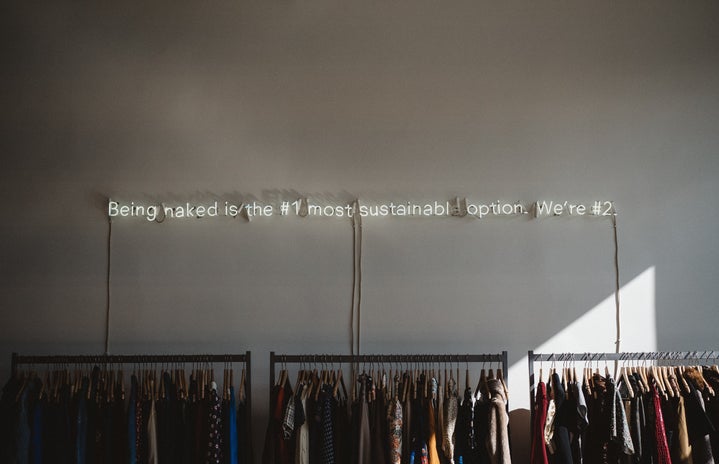To both my family’s and my own dismay, I didn’t end up choosing to attend fashion school, even though my entire life so far has been focused on fashion. At the age of nine, my most prized possession was my collection of sketchbooks, each page was filled with intricate fashion illustrations. At the age of thirteen, I developed a deep love for fashionable cult classic movies. I would imagine myself as the stylish, charismatic main character working a job in the fashion industry and owning a luxurious closet storing every designer item I could dream of.
At the age of seventeen, I discovered the dark side of fashion. Now, that came off a little more dramatic than intended, but let me explain. The summer before my senior year of high school, I took an online course with Parsons School of Design that opened my eyes to the reality of fashion, beyond the beautiful outfits and elegant runway shows. This was also the moment where a once foreign concept became clear to me, the concept of sustainability.
What really is sustainability? Is it just the simple three-step process of reducing, reusing, and recycling? Is decreasing landfill waste, limiting energy consumption, and preventing pollution really it? Is that the key to solving this issue? I believe that sustainability is a bigger concept than just that. After all, it’s a global movement for a reason. Sustainability is about supporting the health and vitality of life on our planet in multiple different aspects. It’s about meeting the current needs of everyone without compromising the ability to meet the needs of future generations. Bottom line is that it’s not just about the environment, but the planet as a whole. Sustainability is a lifestyle and it is a choice.
Unfortunately, the fashion industry hides behind its facade of glitz and glamour. It is one of the most unsustainable and unethical industries. According to The World Bank, the fashion sector is responsible for emitting around 2-3 billion tons of carbon dioxide annually. Research predicts that if this pattern continues, the industry’s greenhouse gas emissions will rise by 50% by the year 2030. The cause of this? The start and popularization of fast fashion.
This is a fairly modern phenomenon that completely transformed the supply chain and retail practices. Before fast fashion, companies would produce a limited number of pieces and drop them in seasonal collections, but with fast fashion, pieces are rapidly mass-produced at a low cost. Data shows that fifty billion pieces of clothing were produced in the year 2000, and twenty years later, that number has doubled. The issue with producing such a high quantity of clothing is that it requires a high number of energy and resources while still resulting in more waste. This creates both an enormous environmental footprint and threatens biodiversity. Not to mention, it puts a further risk on the lives of factory and garment workers worldwide.
Additionally, fast fashion companies frequently copy the creations of hardworking designers and produce cheaper versions of them. This completely removes the authenticity and specialty of the original clothing pieces. If current consumer behaviors continue, the global consumption of clothing will rise 102 million metric tons in ten years, which is detrimental to the planet.
So why has fast fashion become so prevalent? Trends have been ever-changing for centuries, but it’s not like fast fashion has always existed. As a result of this, we know that the main cause cannot be because trends come and go and people want to follow them. The root cause of this issue is the growth in materialism and greed for apparel. Or as I see it – impulse and desire. Humans have always craved a new fresh look by the minute. In order to help this craving, we found our solution to the problem: an unhealthy binge, our very own fashion fix. Human consumerism habits have transformed and somewhere along the way, people started preferring the quantity of clothing over the quality of clothing. The only way to truly put an end to this issue is for everyone to alter their habits and make a small contribution to the health of our planet.
Some of the things I have been trying to do include avoiding shopping at fast fashion stores, upcycling and repairing old clothing, donating or selling clothing items I don’t want rather than throwing them away, and thrifting or purchasing second-hand clothing. I hope you all can start developing these new habits as well.
I may not have that fashion school certification I was once hoping for, but I sure do have the hours I spent passionately researching, writing, understanding, and creating fashion. The hours I spent bettering myself and my own consumption habits. And the hours that I will eventually spend as the founder and CEO of a sustainable fashion company.
Can sustainability be the new sophisticated? Let us know what you think @HerCampusSJSU.


